Discover essential information for selecting the perfect ski boots‚ ensuring optimal fit‚ comfort‚ and performance. This guide simplifies the process with expert advice and key considerations.
Why Proper Ski Boot Fit Matters
Proper ski boot fit is crucial for both comfort and performance on the slopes. Ill-fitting boots can lead to discomfort‚ blisters‚ and fatigue‚ significantly affecting your skiing experience. A good fit ensures optimal support and control‚ which are essential for precise movements and safety‚ especially at higher speeds or on challenging terrain. Additionally‚ proper fit helps prevent injuries by maintaining foot stability within the boot. Customization options‚ such as moldable liners‚ can enhance comfort and performance when the boot fits well initially. Ultimately‚ the right fit ensures an enjoyable and effective skiing experience‚ making it a key factor in choosing the perfect pair of ski boots.
Overview of Key Considerations
When purchasing ski boots‚ several factors must be carefully evaluated to ensure the best choice. These include the boot’s size and fit‚ which can vary between manufacturers and models‚ often requiring in-store try-ons. Flex and stiffness are critical‚ as they impact performance based on skiing ability and personal preference. Features like heat customization‚ walk modes‚ and adjustability enhance functionality. Additionally‚ budget considerations‚ including the decision to buy new or previous-season models‚ play a role. Understanding sizing systems‚ such as Mondo vs. US sizing‚ is also essential. Custom footbeds and the expertise of a boot fitter can further optimize fit and performance‚ making the selection process comprehensive yet rewarding.
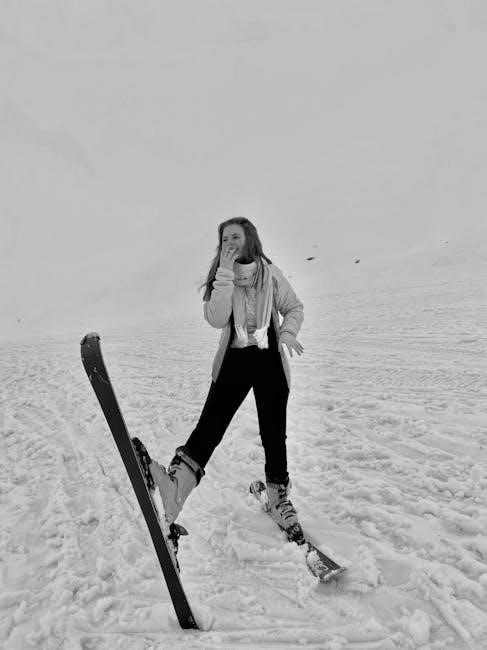
Finding the Perfect Fit and Comfort
Finding the perfect fit ensures optimal performance and comfort. Try boots on to assess shape‚ volume‚ and how they conform to your feet. Custom liners and footbeds can enhance comfort.
How to Determine Your Foot Shape and Volume
To determine your foot shape and volume‚ start by trying on boots to assess how they conform to your feet. Foot shape varies from narrow to wide‚ and volume refers to the overall space your foot occupies. Use tools like a Brannock device or 3D foot scanners to measure length‚ width‚ and arch height. Pay attention to how your toes fit in the boot’s toe box and whether the heel stays snug. If your feet are asymmetrical or have unique features‚ consider custom footbeds for optimal fit. A professional boot fitter can also help analyze your foot shape and recommend boots that match your volume and contours. Proper alignment ensures better control and comfort on the slopes.
The Importance of Trying Boots On
Trying ski boots on is crucial for ensuring proper fit and comfort. Every brand and model fits differently‚ and sizes are not always standardized across manufacturers. Your foot shape‚ volume‚ and personal comfort preferences play a significant role in how a boot will feel. By trying boots on‚ you can assess how well they conform to your feet and identify any pressure points or discomfort. A professional boot fitter can help you find the best match and make necessary adjustments. Remember‚ even if a boot fits well in the store‚ it may feel different on the slopes‚ so take your time to ensure the best fit.
Understanding Comfort and Performance Balance
Finding the right balance between comfort and performance is essential when choosing ski boots. Comfort ensures enjoyable skiing‚ while performance guarantees control and responsiveness on the slopes. Boots that are too soft may lack precision‚ while overly stiff boots can cause discomfort. Skiers must consider their ability level‚ skiing style‚ and how often they hit the slopes. Recreational skiers may prioritize soft flex for ease of movement‚ while advanced skiers prefer stiffer boots for better control. Features like moldable liners‚ adjustable cuffs‚ and customizable insoles help achieve this balance. Ultimately‚ the best boots adapt to your needs‚ offering both comfort and performance without compromise.
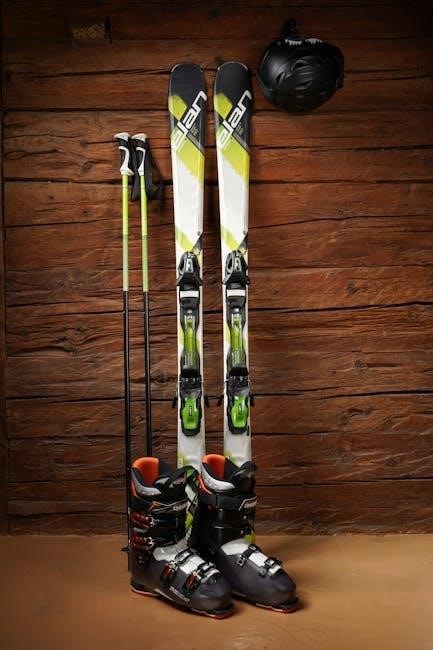
Understanding Sizing for Ski Boots
Ski boot sizing uses both Mondo and US systems‚ ensuring accurate fit. Proper sizing balances comfort and performance‚ with trying boots on being crucial for the best fit.
Mondo Sizing vs. US Sizing: What’s the Difference?
Mondo sizing measures boot length in centimeters‚ directly correlating to foot length‚ offering precise fit. US sizing is less consistent‚ varying by brand and style. Mondo is more accurate for ski boots‚ reducing sizing discrepancies. Understanding both systems helps in selecting the right boot‚ ensuring comfort and performance. Always try boots on‚ as foot shape and volume also impact fit. Proper sizing is crucial for optimal skiing experience.
How to Determine Your Correct Ski Boot Size
Accurately determining your ski boot size involves measuring your foot length and comparing it to the manufacturer’s sizing chart. Use a Brannock device or ruler to measure in centimeters for Mondo sizing. Convert this to US sizes if necessary. Consider factors like foot shape and volume‚ as they influence fit. Try boots on with thin socks‚ ensuring a snug but comfortable feel. A good fit allows toes to wiggle slightly without excessive movement. Proper sizing ensures optimal performance and comfort‚ preventing issues like blisters or restricted blood flow during skiing.
The Role of Custom Footbeds in Fit
Custom footbeds play a crucial role in achieving an optimal ski boot fit. They are tailored to the unique shape of your feet‚ providing additional support and stability. Unlike generic insoles‚ custom footbeds address specific foot issues such as high arches‚ flat feet‚ or uneven pressure distribution. This customization enhances comfort‚ reduces fatigue‚ and improves skiing performance by ensuring better control and responsiveness. A professional boot fitter can create molds of your feet to craft precise‚ supportive footbeds. Investing in custom footbeds is a worthwhile upgrade‚ especially for skiers seeking a more personalized and comfortable fit over extended periods on the slopes.

Flex and Stiffness: What You Need to Know
Flex refers to a ski boot’s resistance when bending forward‚ impacting control and responsiveness. Proper stiffness ensures optimal performance for your skiing style and ability level.
What is Flex Index and How Does It Work?
The flex index measures a boot’s stiffness‚ rated from soft (30) to very stiff (150+). It indicates how much force is needed to bend the boot forward‚ affecting responsiveness and control. A higher index offers more support for aggressive skiing‚ while lower flex suits lighter skiers. Proper flex ensures efficient energy transfer‚ enhancing performance. Matching your ability level and skiing style to the right flex is crucial for optimal comfort and control on the slopes.
Choosing the Right Flex for Your Ability Level
Flex is crucial based on your skiing ability. Beginners benefit from softer flex (30-50) for easier movement and control. Intermediate skiers (50-80) balance responsiveness and forgiveness. Advanced skiers (80-120+) prefer stiffer boots for precision at high speeds. Aggressive skiers or heavier individuals may opt for 120+ flex. Lighter skiers or those prioritizing comfort often choose lower flex. Matching your ability ensures optimal performance and comfort. Try boots on and flex them to gauge the feel‚ as personal preference plays a role. Proper flex alignment enhances skiing efficiency and enjoyment‚ making it a key factor in boot selection.
How Flex Impacts Skiing Performance
Flex significantly influences skiing performance by affecting control‚ stability‚ and responsiveness. Softer flex boots provide forgiveness for beginners‚ allowing easier movement and maneuverability. Stiffer boots deliver precise control and quick response for advanced skiers. Incorrect flex can compromise performance‚ with too-soft boots lacking responsiveness and too-stiff boots causing fatigue. Lighter skiers may prefer lower flex for better control‚ while heavier skiers benefit from higher flex for stability. Proper flex alignment ensures optimal energy transfer‚ enabling better turns and edge grip. Matching flex to your skiing style enhances overall performance‚ making it a critical factor in boot selection for skiers of all levels.

Key Features to Look for in Ski Boots
Look for customizable liners‚ walk modes‚ and adjustability to enhance comfort and performance. Heat-moldable liners provide a tailored fit‚ while walk modes improve mobility off the slopes.
Heat Customization and Moldable Liners
Heat customization and moldable liners are essential features for a personalized fit. These liners can be shaped to match your foot’s unique contours‚ enhancing comfort and reducing pressure points. Proper fitting ensures optimal performance‚ as boots that fit well improve control and responsiveness on the slopes. Custom footbeds also play a crucial role in achieving the best fit‚ especially for those with specific foot shapes or needs. By investing in boots with these features‚ skiers can enjoy a more comfortable and efficient skiing experience‚ allowing them to focus on their technique and enjoyment of the sport.
Walk Mode and Hike Features
Walk mode and hike features in ski boots provide increased flexibility for walking and hiking. This is particularly beneficial for skiers who enjoy touring or backcountry adventures. Boots with walk mode often include a switch that allows the cuff to move more freely‚ reducing strain on the legs during long treks. Additionally‚ some models feature Vibram soles for superior traction on uneven or icy surfaces‚ enhancing stability and control. These designs cater to hikers and skiers who need both performance on the slopes and comfort during ascents. By incorporating walk mode‚ boots offer enhanced versatility‚ making them ideal for those who spend time both skiing and hiking. This feature is a must for anyone seeking a balance between downhill performance and uphill mobility‚ ensuring a more enjoyable and efficient experience on the mountain;
Adjustability and Micro-Adjustments
Adjustability and micro-adjustments in ski boots allow for a customizable fit‚ ensuring optimal comfort and performance. Key features include adjustable buckles‚ straps‚ and cuffs that can be tailored to individual foot shapes and skiing styles. Micro-adjustments enable fine-tuning‚ such as tightening or loosening specific areas for a precise fit. This adaptability is crucial for skiers with unique foot anatomy or those who prioritize comfort during long days on the slopes. High-end boots often offer more extensive adjustability options‚ making them ideal for serious skiers seeking a tailored fit. Proper adjustments can enhance control‚ reduce pressure points‚ and improve overall skiing efficiency‚ ensuring a more enjoyable experience on the mountain. These features are essential for maximizing both comfort and performance in varying skiing conditions.
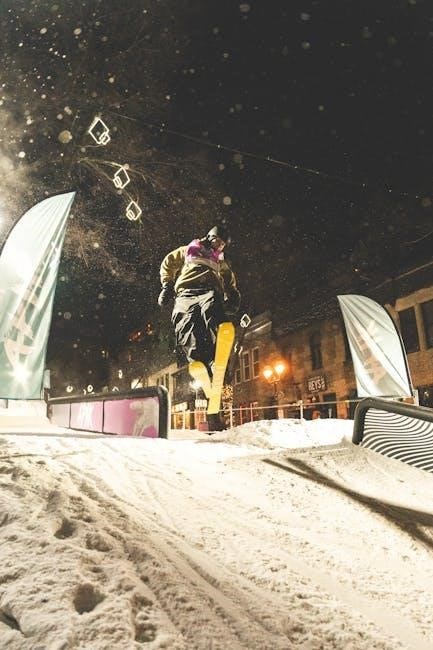
Different Types of Ski Boots
Explore various ski boot categories‚ including all-mountain‚ freeride‚ race‚ and touring boots‚ each designed for specific skiing styles and terrains‚ ensuring the right fit for every skier.
All-Mountain Ski Boots: Versatility Explained
All-mountain ski boots are designed for versatility‚ catering to skiers who explore various terrains and conditions. They balance performance and comfort‚ making them suitable for both groomed trails and off-piste adventures. These boots typically feature moderate flex ratings‚ allowing responsiveness for carving turns while remaining forgiving for casual skiing. Many models include customizable liners and adjustable features to accommodate different foot shapes and skiing styles. Whether you’re a beginner or an advanced skier‚ all-mountain boots adapt well to diverse skiing preferences. Their versatility ensures they remain a popular choice for those seeking a boot that excels in multiple scenarios without compromising on performance or comfort.
Freeride and Backcountry Ski Boots
Freeride and backcountry ski boots are designed for adventurous skiers who venture into ungroomed terrain and challenging conditions. These boots prioritize durability‚ flexibility‚ and mobility‚ offering a higher flex index for better control in deep snow and rough landscapes. They often feature walk modes and lightweight constructions to facilitate hiking and uphill travel. Many models include gaiter compatibility and waterproofing to withstand harsh weather conditions. Customizable liners and adjustable cuffs ensure a precise fit‚ while robust soles provide excellent grip for traversing uneven ground. Whether tackling steep descents or long backcountry tours‚ these boots deliver the performance and reliability needed for extreme skiing adventures.
Race and High-Performance Boots
Race and high-performance boots are designed for elite skiers seeking maximum precision and speed. These boots feature a high flex index‚ offering exceptional stiffness for sharp‚ responsive turns. Lightweight yet durable materials ensure optimal power transfer without compromising agility. Customizable liners and precise fitting systems enhance performance‚ catering to competitive skiers. Advanced features like heat-moldable shells and adjustable cuff alignment provide a tailored fit for ultimate control. Whether on groomed slopes or race courses‚ these boots deliver the responsiveness and edge hold needed for high-speed skiing. They are ideal for experienced skiers who prioritize performance over comfort‚ making them a top choice for racing and advanced skiing.
Touring Ski Boots: Lightweight Options
Touring ski boots are designed for backcountry skiing‚ emphasizing lightweight construction for efficient uphill travel while maintaining downhill performance. They typically feature walk modes‚ offering a comfortable range of motion for hiking. These boots often use lightweight yet durable materials‚ such as carbon fiber or Grilamid‚ to reduce weight without sacrificing responsiveness. Many touring boots include gaiter-compatible designs and compatibility with ski crampons for technical terrain. A well-fitting touring boot balances comfort and support‚ ensuring all-day wearability. When choosing‚ consider your skiing ability‚ touring frequency‚ and the type of terrain you’ll encounter. Proper fit and compatibility with bindings and skins are also crucial for optimal performance.
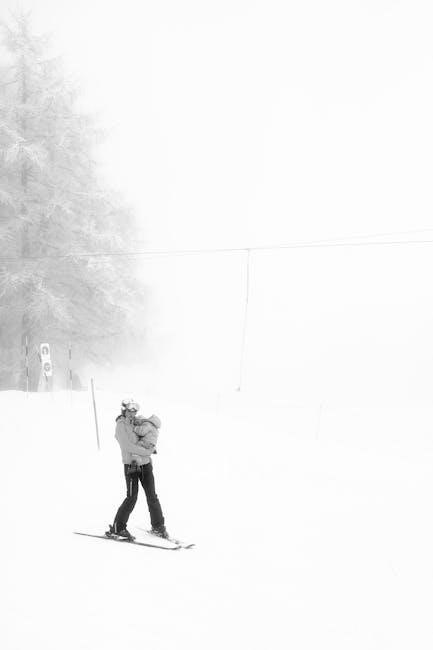
Where to Buy Your Ski Boots
Explore options like local ski shops for personalized fitting or online retailers for convenience. Professional boot fitters can provide expert advice for the best fit and performance.
Local Ski Shops vs. Online Retailers
When deciding where to buy ski boots‚ consider the benefits of local shops versus online retailers. Local ski shops offer personalized fitting sessions with experienced staff‚ ensuring a precise fit and addressing specific needs; They also provide immediate feedback and adjustments‚ enhancing the overall buying experience. On the other hand‚ online retailers often offer a wider selection and competitive pricing‚ with the convenience of shopping from home. However‚ fit accuracy can be challenging without trying boots on. Some online platforms now offer virtual fitting tools or generous return policies to mitigate this issue. Balancing convenience and expert advice is key to making the best choice.
How to Find a Good Boot Fitter
Finding a skilled boot fitter is crucial for a perfect fit. Look for shops with certified professionals‚ often affiliated with organizations like Masterfit. Check reviews and ask for recommendations from fellow skiers. A good fitter will assess your foot shape‚ volume‚ and skiing style to recommend ideal boots. They may also suggest custom footbeds for enhanced comfort and performance. Be wary of fitters who rely solely on your shoe size; proper fitting involves trying on multiple boots and making adjustments. Trusting an experienced fitter ensures your boots meet your needs‚ improving your skiing experience and preventing discomfort on the slopes.
Pros and Cons of Buying Online
Buying ski boots online offers convenience and potential cost savings‚ but it requires careful consideration. Pros include accessing a wider selection‚ comparing prices easily‚ and often finding deals or discounts. However‚ cons include the inability to try boots on before purchase‚ which is critical for ensuring proper fit. Returning or exchanging boots can also be inconvenient and costly. To mitigate risks‚ use detailed sizing guides‚ read reviews‚ and ensure the retailer offers a flexible return policy. Additionally‚ some online retailers partner with local shops for in-person trials. Balancing convenience with fit accuracy is key to a successful online purchase.

Budgeting for Your Ski Boots
Set a budget considering your skiing frequency and goals. Entry-level boots are affordable‚ while high-end models offer advanced features. Look for discounts on last season’s models.
Entry-Level vs. High-End Boots: Cost Considerations
Budgeting for ski boots involves weighing entry-level and high-end options. Entry-level boots‚ priced between $200-$400‚ are ideal for casual skiers‚ offering basic features and decent performance. High-end boots‚ ranging from $600-$1‚000‚ cater to advanced skiers‚ providing superior flex‚ customization‚ and durability. Consider your skiing frequency and goals when deciding. Occasional skiers may find entry-level boots sufficient‚ while frequent skiers or those seeking optimal performance might justify the investment in high-end models. Balancing cost and quality ensures the right boot for your needs without overspending.
How to Find Deals and Discounts
Finding deals on ski boots can save you money without compromising on quality. Consider purchasing last season’s models‚ which often come at a lower price point while offering similar performance. Consider shopping during off-season sales or Black Friday events for discounts. Additionally‚ check online retailers for price comparisons and sign up for newsletters to receive exclusive offers. Some ski shops offer bundle deals when buying boots with other equipment. Finally‚ keep an eye on local ski shops or online marketplaces for clearance sections or special promotions. Timing your purchase strategically can help you secure high-quality boots at a more affordable price.
Should You Buy Last Season’s Model?
Purchasing last season’s ski boot model can be a smart decision for budget-conscious buyers. Typically‚ these boots offer similar performance and features to the latest models but at a lower price. You can often save $300 or more‚ with the main differences being cosmetic‚ such as color or design. However‚ consider whether newer models include significant technological advancements that justify the extra cost. If the updates are minimal‚ opting for last season’s model is a cost-effective choice. Ensure the boots still meet your needs for fit‚ flex‚ and functionality before making your decision.
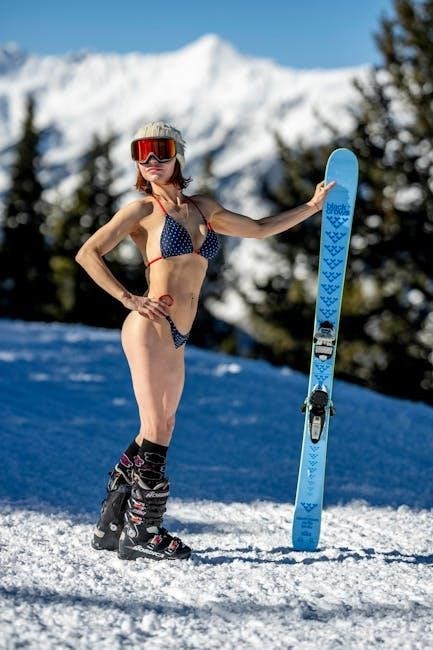
Maintenance and Care for Ski Boots
Proper maintenance ensures longevity and performance. Clean and dry boots after use‚ store them properly‚ and replace when worn. Regular care enhances comfort and durability.
Cleaning and Drying Your Boots
Regular cleaning and proper drying are crucial for maintaining your ski boots’ performance and longevity. Use a soft cloth and mild soap to wipe down the exterior‚ avoiding harsh chemicals that may damage materials. For the interior‚ remove liners and let them air dry away from direct heat. Stuffing boots with newspaper or using desiccants can absorb moisture effectively. Never expose boots to direct sunlight or heaters‚ as this can cause warping or drying out. Allow boots to dry naturally between uses to prevent mold and odor buildup. Proper care ensures your boots remain comfortable and functional for years to come.
Storing Your Boots Properly

Proper storage is essential to maintain the condition and performance of your ski boots. After cleaning and drying‚ remove the liners and store them separately to prevent moisture buildup. Keep the boots in a cool‚ dry place away from direct sunlight and heat sources‚ as these can cause materials to degrade. Avoid storing boots in ski bags‚ as this can trap moisture. Instead‚ place them upright or lay them flat in a well-ventilated area. Use desiccants or silica packets to absorb any remaining moisture. Regularly inspect for damage before storing. Proper storage ensures your boots remain in excellent condition for future use.
When to Replace Your Ski Boots
Replace your ski boots when they no longer provide proper support or performance. Signs include a loose fit‚ worn-out liners‚ or a cracked shell. If the boots no longer hold your foot securely‚ causing discomfort or affecting control‚ it’s time to upgrade. Typically‚ high-quality boots last around 200-300 skiing days. If the soles are worn or the heel is overly worn‚ replacement is necessary. Additionally‚ if the flex has softened significantly‚ impacting responsiveness‚ new boots are recommended. Addressing these issues ensures optimal performance and comfort on the slopes.
With this guide‚ you’re equipped to make an informed decision. Invest in quality‚ comfort‚ and performance to enhance your skiing experience confidently.
Final Tips for a Successful Purchase
When purchasing ski boots‚ prioritize proper fit and comfort above all else. Try boots on in the afternoon‚ as feet swell throughout the day. Consider your ability level and skiing style to choose the right flex and features. Don’t overspend on unnecessary technology; stick to your budget. Custom footbeds and moldable liners can enhance fit and performance. Seek advice from a professional boot fitter for personalized recommendations. Lastly‚ consider future-proofing your purchase by investing in durable‚ high-quality boots. By following these tips‚ you’ll ensure a comfortable and enjoyable skiing experience for years to come;
Encouragement to Take the Next Step
Now that you’ve gained valuable insights into selecting the perfect ski boots‚ it’s time to act! Visit a local ski shop or trusted online retailer to explore options. Schedule a boot fitting session with a professional to ensure the best fit. Remember‚ the right boots can transform your skiing experience‚ offering comfort‚ performance‚ and confidence. Don’t hesitate to invest in quality‚ as it pays off in the long run. Start your journey to better skiing today—your next adventure on the slopes awaits!